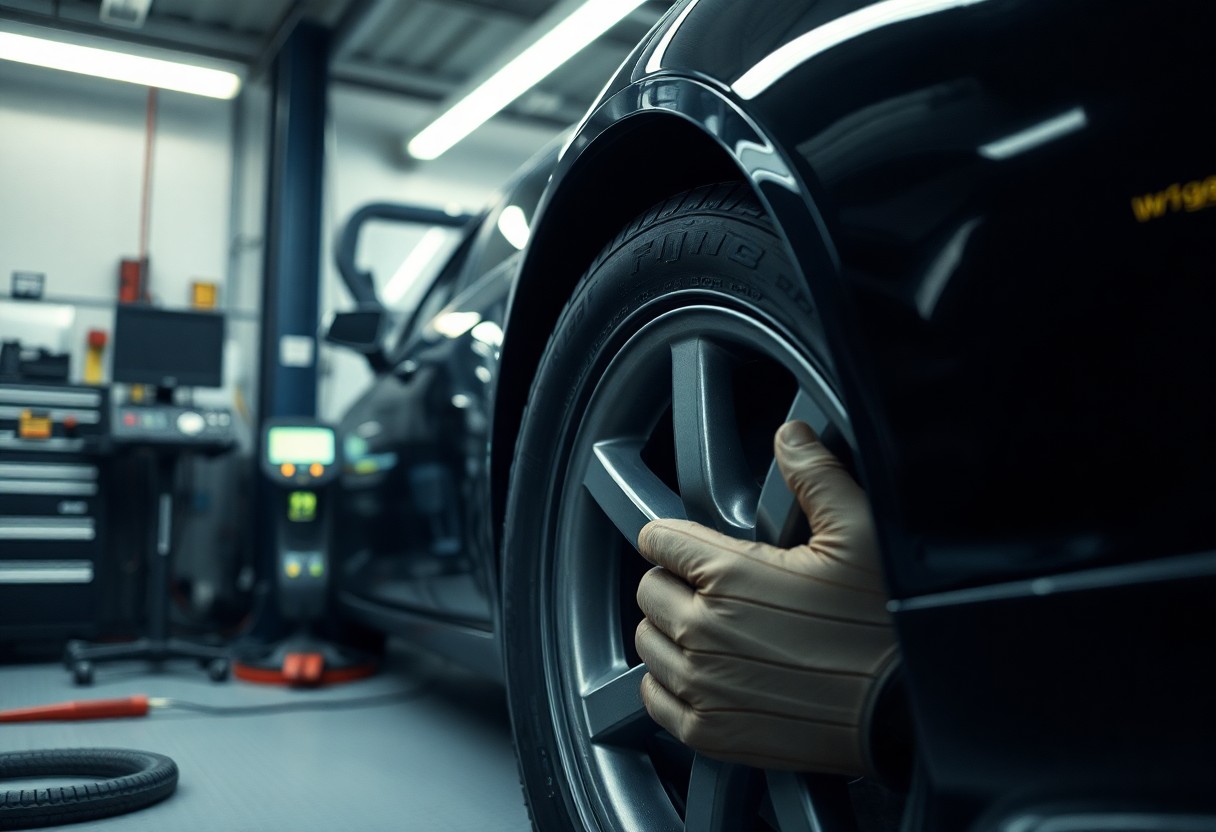With your car vibrating while driving in Klang, this unsettling experience could indicate a serious issue with your tyres. It’s necessary to recognize that uneven wear, low pressure, or damage in your tyres can not only affect your driving comfort but also compromise your safety on the road. Addressing these problems promptly can help prevent further complications and keep your vehicle running smoothly. By checking and maintaining your tyres regularly, you can enhance your driving experience while ensuring your safety and that of your passengers.

Key Takeaways:
- Vibrations in your car can often be traced back to issues with your tyres.
- Imbalanced or misaligned tyres can lead to significant driving discomfort and potential safety hazards.
- Tyre tread wear can contribute to vibrations; inspect for any signs of uneven wear.
- Proper inflation of tyres is important, as under-inflated or over-inflated tyres can cause vibrations.
- Regular tyre maintenance and alignment checks can help prevent vibrations and extend tyre life.
- Consulting a professional mechanic can provide insights into whether your tyres are the source of the vibrations.
- Ignoring vibrating tyres can lead to more severe mechanical issues over time, impacting overall vehicle performance.
The Role of Tyres in Vehicle Performance
Your vehicle’s performance largely hinges on the condition and type of tyres you use. They serve as the critical interface between your car and the road, impacting traction, handling, and fuel efficiency. High-performance tyres can enhance grip and stability, particularly during high-speed maneuvers, while worn or damaged tyres can lead to diminished performance and increased risk of accidents. Investing in quality tyres and maintaining them properly not only optimizes your vehicle’s performance but also enhances your overall driving experience.
How Tyre Condition Affects Ride Quality
The state of your tyres directly influences your ride quality. Worn or poorly inflated tyres can make your journey bumpy, leading to discomfort as various surface irregularities are not adequately absorbed. With proper tread depth and optimal inflation, your tyres can provide better shock absorption and stability, ensuring a smoother drive. Additionally, good tyre condition allows for improved steering response, giving you the confidence to handle any driving situation effectively. Ignoring tyre maintenance can negatively impact your comfort on the road.
The Link Between Tyre Wear and Vibration
Vibrations in your car are often symptomatic of the condition of your tyres. When tyres become unevenly worn, they lose their ability to maintain contact with the road, which can result in unsettling vibrations felt throughout the vehicle. Factors like misalignment, improper inflation, or even hitting potholes can contribute to accelerated tyre wear. Being attentive to these signs and addressing issues promptly can restore ride quality and enhance safety on the road.
When tyre wear goes unchecked, it not only leads to vibrations but can also accelerate the wear of suspension components and other crucial parts of your vehicle. For example, uneven tread wear can cause your vehicle to shake, ultimately affecting steering precision. Regular inspections and maintenance can curb such problems—ensuring your tyres are rotated, balanced, and aligned appropriately helps maintain an even distribution of wear, significantly reducing the likelihood of vibrations while driving.
Diagnostic Tools for Identifying Tyre Issues
Identifying tyre issues requires a combination of traditional methods and advanced technology. Employing the right diagnostic tools enables you to accurately assess the condition of your tyres, helping to eliminate guesswork and ensuring your vehicle operates safely and efficiently.
Visual Inspection Techniques to Detect Problems
Start with a thorough visual inspection of your tyres to identify visible signs of damage. Look for uneven wear patterns, cracks, bulges, or foreign objects lodged in the tread. Checking the tyre pressure ensures they are properly inflated, as under-inflation or over-inflation can also be evident visually and lead to vibrations.
Using Technology: Balancers and Alignment Tools
Modern diagnostic tools like wheel balancers and alignment tools are necessary for detecting imbalances and misalignments that contribute to vibrations. These machines measure the weight distribution on your wheels, pinpointing any discrepancies that necessitate adjustment.
For instance, a wheel balancer utilizes sensors to detect how weight is distributed around the wheel, ensuring even weight distribution leads to a smooth ride. If a wheel is unbalanced, it causes vibrations that can affect handling and wear on suspension components. Similarly, alignment tools measure the angles of your wheels in relation to the vehicle’s frame, providing data that can indicate if adjustments are required. Keeping your tyres balanced and aligned not only enhances comfort but can also improve your fuel efficiency by up to 10%, saving you money over time.

Common Tyre-Related Causes of Car Vibration
Several tyre-related factors can cause your car to vibrate, leading to an uncomfortable driving experience. Issues such as uneven wear patterns, incorrect tyre pressure, and misalignment can contribute to these vibrations. Addressing these concerns quickly can not only enhance your ride comfort but also improve vehicle safety.
Uneven Wear Patterns and Their Implications
Uneven wear patterns on your tyres often stem from poor alignment or suspension problems. This can lead to noticeable vibrations and affect your vehicle’s handling. Left unchecked, uneven wear can shorten the lifespan of your tyres and compromise your safety, making regular inspections vital.
The Impact of Tyre Pressure on Vehicle Stability
Tyre pressure significantly influences your vehicle’s stability. Keeping your tyres properly inflated helps maintain optimal contact with the road, enhancing traction and stability. Under-inflated tyres can lead to a bumpy ride and increased fuel consumption, while over-inflated tyres may cause unpredictable handling.
When your tyres are not adequately inflated, the sidewall flexes more, leading to excessive heat buildup and accelerated wear. Studies have shown that driving with just 10 PSI lower than recommended can reduce tread life by up to 25%. This not only creates vibrations but also diminishes overall driving safety, increasing the risk of blowouts and accidents. Regular pressure checks, ideally monthly or before long trips, are vital to ensure your tyres remain safe and efficient.
Maintenance Practices to Prevent Vibrations
Maintaining your tyres is crucial to ensure a smooth driving experience and prevent vibrations. Implementing regular checks and adopting best practices can keep your tyres in optimal condition, ultimately enhancing your vehicle’s performance and safety.
Regular Rotation and Alignment: Best Practices
Ensuring regular tyre rotation and alignment enhances the lifespan of your tyres and improves handling. Aim to rotate your tyres every 5,000 to 8,000 kilometres or as recommended by your vehicle’s manufacturer. Alignment should be checked whenever you notice uneven wear, or after hitting a pothole, helping to reduce vibrations that indicate misalignment.
When to Replace Tyres: Signs to Watch For
It’s vital to be aware of the signs indicating it’s time to replace your tyres. Look for consistent vibrations, low tread depth, visible cracks, or bulges, as these can signal potential hazards. Pay attention to the wear pattern; uneven tread indicates a need for immediate attention, often suggesting the tyres are beyond their safe lifespan.
Monitoring your tyres for signs of wear can save you from future headaches. For example, a tread depth of less than 1.6 millimetres suggests replacement is needed. Additionally, check for any sidewall damage or noticeable vibration when driving, as these are critical indicators of tyre health. Keeping an eye on these details not only enhances your driving experience but also ensures your safety on the road.

Seeking Professional Help: When It’s Time to Consult an Expert
Once you’ve made some preliminary assessments and reviewed your tyre maintenance, it may become apparent that further expertise is needed. If vibrations persist despite your best efforts, consulting a professional is a wise move. Experts can provide a deeper diagnostic evaluation that goes beyond visible inspection. This can prevent potential safety hazards, allowing you to drive with confidence.
Identifying Red Flags for Serious Problems
Several signs indicate that you should seek professional help immediately. If vibrations intensify at higher speeds, or if you notice uneven tyre wear, bulges, or cracks, it’s time to consult an expert. Strange noises accompanying the vibrations are also major red flags that suggest serious underlying issues, possibly related to your tyre alignment or suspension.
What to Expect During a Professional Inspection
A professional inspection typically involves an extensive evaluation of your vehicle’s tyres and suspension system. Expect the technician to check for structural integrity, alignment issues, and balance of your tyres. They may use advanced diagnostic tools that identify problems not visible to the naked eye, ensuring you receive a comprehensive analysis of your vehicle’s condition.
During the inspection, the technician will likely perform a road test, assessing performance at various speeds. They will visually examine tyres for signs of wear and tear and may use specialised equipment to measure balance and alignment. This thorough inspection ensures that not only immediate issues are addressed but also prolongs the lifespan of your tyres by preventing future complications. By understanding what is involved, you can make informed decisions to keep your vehicle safe and functional.
To wrap up
Upon reflecting, if your car vibrates while driving in Klang, it’s crucial to consider the state of your tyres. Worn-out, improperly inflated, or unbalanced tyres can lead to vibrations that not only compromise your driving experience but may also pose safety risks. Regularly inspecting your tyres and ensuring they’re in good condition can help you maintain a smooth ride and enhance vehicle performance. By addressing tyre issues promptly, you can enjoy a safer journey and potentially extend the life of your vehicle.
FAQ
Q: What are the common reasons for a car vibrating in Klang?
A: Common reasons for car vibrations can include unbalanced wheels, misaligned tyres, damaged wheel bearings, and issues with the suspension system. Tyre problems such as uneven wear or low pressure can also contribute significantly to vibrations.
Q: How can I tell if my tyres are causing the vibration?
A: If the vibration occurs primarily while driving at certain speeds, particularly at higher speeds, it may indicate an issue with your tyres. Visual inspection for uneven wear patterns, and checking tyre pressure are good starting points. Additionally, if the vibration stops or diminishes when braking, it might indicate a problem isolated to the tyres.
Q: What should I do if I suspect my tyres are the issue?
A: If you suspect that your tyres are causing the vibration, you should take your vehicle to a trusted mechanic or tyre service shop. They can perform a thorough inspection, check the balance and alignment of your wheels, and assess your tyres for any signs of damage or wear.
Q: How often should I check my tyres to prevent vibrations?
A: It is advisable to check your tyres at least once a month for proper inflation and visual damage. Additionally, regular rotations and alignments every 5,000 to 7,500 kilometers can help maintain tyre health and reduce the risk of vibrations.
Q: Can a wheel alignment fix vibrating issues?
A: Yes, a proper wheel alignment can help resolve vibrations caused by misaligned tyres. When your wheels are aligned correctly, they will have better contact with the road, which can lead to a smoother driving experience and less vibration.
Q: What are the signs of damaged tyres that might lead to vibrations?
A: Signs of damaged tyres may include bulges, cracks, or punctures visible on the tyre surface. Uneven tread wear, where one side appears more worn than the other, and a flat spot on the tyre can also indicate issues that may cause vibrations while driving.
Q: Is it safe to drive my car if it is vibrating due to tyre issues?
A: It is generally unsafe to drive a vehicle that is vibrating due to tyre issues. Continuing to drive under these conditions can lead to further damage to your vehicle and may result in a loss of control while driving. It is best to address the issue promptly before getting back on the road.
